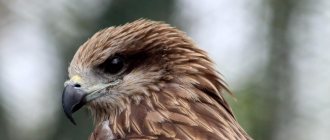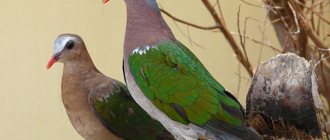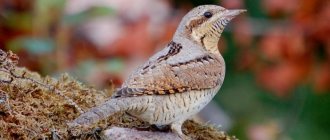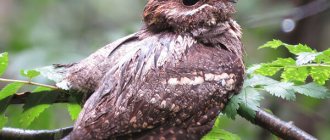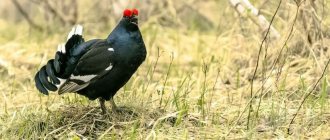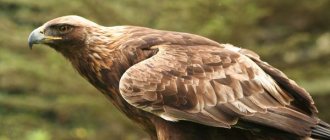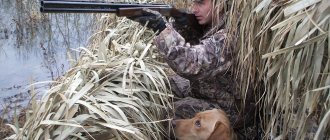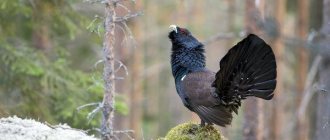- Wild animals
- >>
- Birds
An inhabitant of cold seas, the loon is not only a bird perfectly adapted to extremely harsh climate conditions, but also an unusually beautiful creature that stands out from its relatives. Unfortunately, she is not able to adapt to our very turbulent age and needs special, delicate treatment.
Origin of the species and description
Photo: Loon
The loon is a northern waterfowl from the order Gagariformes. This is one of the most ancient and compact groups of birds among modern birds. The oldest fossil dates back to the Upper Oligocene of North America; a total of nine species of loon fossils are known.
Today there are only five:
- blackbill;
- black or black-throated - the most common species;
- red-throated;
- white-billed;
- white-necked
All of them differ only in appearance; their lifestyle and behavior are completely identical. Previously, zoologists identified only four species, but recent scientific research has revealed that the white-necked variety is not a subspecies of the black one, but represents an independent species.
Video: Loon
For a long time, loons were considered close relatives of grebes due to their similar appearance and lifestyle, but later zoologists agreed that birds have similar features only due to convergent evolution.
In morphology and ecology, these two orders have nothing in common. In terms of kinship and morphology, loons are close to tubenoses and penguins.
Interesting fact: The loon's skeletal bones are hard and heavy, not hollow like those of other bird species. Thanks to this, they are excellently adapted to life in an aquatic environment and do not even go onto land to sleep.
Taxonomy
Stuffed Great Auk, Leipzig
The great auk was one of the 4,400 species of animals first described by Carl Linnaeus in his work System of Nature. In it, the great auk was named Alca impennis
, which did not change until 1791.
The genus name comes from the Spanish-Portuguese word alca
, which meant "auk".
In turn, the species name of the bird comes from the Latin word impennis
, which meant
“absence of flight feathers
.
The bird received a similar Latin name for its short wings, which did not allow it to fly. Some ornithologists believe that the most appropriate genus name would be Alca
, since the taxonomic bird genus name
Pinguinus
was more associated with penguins than auks.
Analysis of the nucleotide sequence of mitochondrial DNA showed that the closest relative of the great auk is the species Alca torda
.
A close relative of the great auk is also the little auk, a bird of the auk family, the origin of which is very different from the representatives of the genus Pinguinus
.
Despite its large size and inability to fly, the great auk is often placed in the genus Alca
, following Linnaeus' classification.
Alca
is a derived word from Old Norse that means
"auk"
.
Fossils (especially Pinguinus alfrednewtoni
) and molecular gene studies have shown that auks, great auks and little auks diverged from each other after their common ancestor, presumably similar to
Synthliboramphus hypoleucus
, spread throughout the North Atlantic.
By this time, the Atlantic guillemots had apparently already separated from other auks of the North Atlantic. Despite the fact that the auk was widespread during the Pliocene, the origin of the auk is extremely poorly understood. Molecular data obtained from the study of the bird's remains showed that the great auk should be separated into a separate genus, since it was not related to others such as Mancalla
,
Praemancalla
and
Pan-Alcidae
.
Pinguinus alfrednewtoni
was the largest flightless member of the genus
Pinguinus
, which lived in the early Pliocene.
Based on known remains found in North Carolina, it is believed that the great auk and Pinguinus alfrednewtoni
diverged almost simultaneously from their common ancestor.
Pinguinus alfrednewtoni
lived in the western part of the Atlantic Ocean, while the great auk lived in the eastern part.
After Pinguinus alfrednewtoni
became extinct, the great auk spread throughout the North Atlantic.
The only known illustration of a living great auk, painted by Ole Vorm in the Faroe Islands
The Basques called the great auk arponaz
, which in their language meant “spear beak.”
In Old French the bird was called bird apponatz
, and Spanish and Portuguese sailors called it
pingüinos
The Norwegians called the great auk
geirfugl
, which in their language meant “spear bird.”
From this name comes the common English names for the bird - garefowl
or
gairfowl
.
The Eskimos called the great auk isarukitsck
, which in their language meant "small wing".
The Welsh called this species pingwen
(the word is actually spelled
pengwyn
), which meant "white head" in their language. When European explorers in the Southern Hemisphere discovered the penguins we know today, they noticed that these birds were similar in appearance to the great auk and decided to name them the same as the above-mentioned species. It is worth noting that the great auk and penguins are not related to each other.
Appearance and features
Photo: What a loon looks like
The loon is similar in body shape and size to a large duck or goose; some individuals reach larger sizes and gain weight of more than 6 kilograms. Loons have a pointed beak and differ from many waterfowl in the beauty of the colors of their plumage.
In appearance, males do not differ from females:
- the belly is white, and the upper part of the body is black or grayish-brown with a large number of white spots;
- the head and neck are decorated with a pattern characteristic of each species.
During the wintering period, young and adult loons have no pattern and the color of the plumage is monotonous. The most beautiful among the loons are the red-breasted small ducks. The bright pink stripe on her neck is very similar to a tie and is the main distinguishing feature.
Loons have small wings relative to their body. During flight, they “stoop” a little, arching their necks strongly, and stretch their legs back, which makes them look like a tail. By their “stooped” appearance, they can be distinguished even in flight from ordinary ducks or geese.
The three outer toes on the loon's feet are connected by a membrane, so they feel excellent in the water and very unsteady on land. And the feathers of birds are very soft and pleasant to the touch. Warm, thick plumage protects loons from hypothermia.
Notes
- Vinokurov A. A.
Rare and endangered animals. Birds / Ed. V. E. Sokolova. - M.: Higher School, 1992. - P. 56. - 100,000 copies. — ISBN 5-06-002116-5. - Mowat, Farley.
Sea of Slaughter. - Progress, 1984. - ISBN 5-010-01079-8. - ↑ Cokinos 2000, p. 331
- Linnaeus, C.
Systema naturae per regna tria naturae, secundum classes, ordines, genera, species, cum characteribus, differentiis, synonymis, locis. Tomus I. Editio decima, reformata.. - Holmiae: Laurentii Salvii, 1758. - P. 130. - ↑
- ↑
- Fuller, Errol.
The Great Auk. — illustrated. - Southborough, Kent, UK: Privately Published, 1999. - P. 401. - ISBN 0-9533553-0-6. - ↑
- ↑
- Biology project Animals that disappeared due to human fault in the Voronezh region
↑
- ↑ Cokinos 2000, p. 333
- ↑ Cokinos 2000, p. 314
- ↑ Crofford 1989, p. 8
- Crofford 1989, p. 10
- ↑
- Crofford 1989, p. 15
- ↑ Crofford 1989, p. 28
- ↑ Crofford 1989, p. 9
- ↑ Cokinos 2000, p. 310
- ↑ Crofford 1989, p. 29
- ↑
- ↑ Cokinos 2000, p. 312
- ↑
- ↑
- ↑ Crofford 1989, p. 5
- ↑
- ↑ Crofford 1989, p. thirty
- ↑
- Relics of the Great Auk on Funk Island, by John Milne. The Field, March 27, April 3,10,1875.
- ↑
- ↑
- Bay of Marausa
- ↑ Crofford 1989, p. 35
- Cokinos 2000, p. 315
- ↑ Cokinos 2000, p. 313
- ↑ Crofford 1989, p. 32
- ↑ Cokinos 2000, p. 311
- ↑
- Olson, Storrs L; Swift, Camm C. & Mokhiber, Carmine (1979). “An attempt to determine the prey of the Great Auk ( Pinguinus impennis
).”
The Auk
.
96
(4): 790–792. JSTOR. - ↑
- ↑
- Crofford 1989, p. 33
- ↑
- Crofford 1989, p. 6
- ↑ Tuck, James A. (1976). “Ancient peoples of Port au Choix: The excavation of an Archaic Indian cemetery in Newfoundland.” Newfoundland Social and Economic Studies
.
St. John's: Institute of Social and Economic Research, Memorial U of Newfoundland. 17
:261. - ↑
- Greenway, James C.
Extinct and Vanishing Birds of the World, 2nd Edition. - New York: Dover Publications, 1967. - P. 271-291. — ISBN 978-0-486-21869-4. - Crofford 1989, p. 38
- Crofford 1989, p. 39
- Crofford 1989, p. 40
- Cokinos 2000, p. 330
- Cokinos 2000, p. 329
- Rackwitz, Martin.
Travels to Terra Incognita: The Scottish Highlands and Hebrides in Early Modern Travellers' Accounts C. 1600 to 1800. - Waxmann Verlag, 2007. - P. 347. - ISBN 978-3-8309-1699-4. - ↑
- ↑ Crofford 1989, p. 43
- Ellis, Richard.
No Turning Back: The Life and Death of Animal Species. - New York: Harper Perennial, 2004. - P. 160. - ISBN 0-06-055804-0. - ↑ Luther, Dieter.
Die ausgestorbenen Vögel der Welt. - 4. - Heidelberg: Westarp-Wissenschaften, 1996. - P. 78-84. — ISBN 3-89432-213-6. - Fuller, Errol (1999). The Great Auk. ISBN 0-9533553-0-6
- Kingsley, Charles.
The Water-Babies, A Fairy Tale for a Land Baby. - Oxford: Oxford University Press, 1995. - ISBN 0-19-282238-1. - ↑ Blyton, Enid.
The Island of Adventure. - London: Macmillan, 1944. - Mowat, Farley.
Sea of Slaughter. - New York: Bantam Books, 1986. - P. 18. - ISBN 0-553-34269-X. - Ford, Walton.
Pancha Tantra. — illustrated. - Los Angeles: Taschen America LLC, 2009. - ISBN 3-8228-5237-6. - Fuller, Errol.
The Great Auk. — illustrated. - Southborough, Kent, UK: Privately Published, 1999. - ISBN 0-9533553-0-6. - Jeffes, Simon.
'Still Life' at the Penguin Cafe. - London: Peters Edition Ltd, 2002. - ISBN 0-9542720-0-5.
Where does the loon live?
Photo: Loon bird
Loons prefer the cold waters of northern seas and lakes. Their main habitats are Europe, Asia and all of North America. Loons are found in the tundra, mountains, and forests, provided there is a body of water nearby, since they spend their entire lives near water and on the water. Some individuals come to land only during the mating season and to lay eggs.
When water bodies freeze, birds fly in groups to non-freezing water bodies. They winter mainly on the Black, Baltic or White Seas, the coasts of the Pacific and Atlantic Oceans. Loons have unusual migration behavior, where the route to the wintering grounds differs from the route of migration from the wintering grounds, which is typical for only a few species of birds.
Young loons remain in warm waters throughout their first summer, sometimes even until they reach sexual maturity. In spring, loons always arrive late, when there is already plenty of clean water.
Interesting fact: The indigenous inhabitants of the Far North hunt loons in limited quantities together with other commercial bird species to use their meat for food. Also, previously there was a special fishery for loons for “bird fur” or “loon necks”, but due to changes in fashion and a drop in demand, it is not carried out today.
Habitat
White-billed loons live in tundra areas along coastlines near fresh and salt water. The choice of habitat depends on safety factors, the ability to protect the eggs and damage to the nest caused by strong waves and predators, as well as the availability of food. Birds are more often found on the coastline because they prefer to fish in shallow water and nest there.
- Habitat: polar marine or marine freshwater.
- Terrestrial biomes: tundra.
- Aquatic biomes: lakes, ponds, rivers, streams.
Area
The birds are found in northwestern North America and northern Eurasia. The breeding range also includes northern Russia, Canada and Alaska. Loons are densely populated in areas of the Alaska Oil Plant, extending from the Colville River west to Wainwright.
The birds' winter habitat includes the northern coastal regions of the Pacific Ocean. This includes the west coast of the United States and Canada, the northern coast of Finland, and coastal areas of Japan and China.
What does a loon eat?
Photo: Black loon
Small fish that live at shallow depths in seas and lakes constitute the usual diet of loons. When fishing, the bird first plunges its head into the water, exploring the space below it, and then dives silently. In pursuit of prey, loons are capable of diving to several tens of meters and holding their breath for 90 seconds.
During rapid movement in the water column, they mainly use webbed paws, which are always shifted far back. Very rarely, when diving, the wings are used; most often they remain tightly laid on the back and protected from getting wet by the covert feathers of the back, wings and elongated side feathers, forming a kind of pocket. Additional protection from getting wet is the fat of the supra-tail coptic gland, which loons lubricate their plumage with.
If there is not enough fish, then loons can feed on almost everything that the waters of the seas and lakes are rich in: mollusks, crustaceans, various insects. Birds don't even disdain algae. Sometimes, while diving into the depths for fish, they get caught in fishing nets.
Interesting fact: Loons, together with penguins, are absolute record holders for diving depth. There are known cases when these birds were caught by fishermen at a depth of about 70 meters.
Nutrition
Birds obtain food by diving and swimming underwater. Loons often swim along the surface with their heads partially submerged: they peer under the water, watching for prey, before diving. Birds use their legs to move, as well as their wings to turn and gain speed. Basically, loons feed on what is in sight.
During the colder months, the bird feeds on small fish, including gobies, thornbills, herring, cod and others. In summer and during the breeding season, the diet of individuals becomes more varied. For example, birds eat crustaceans, mollusks, and aquatic insects. The loon rarely eats frogs and leeches.
Features of character and lifestyle
Loons are predominantly seabirds, and they fly to freshwater lakes only during the nesting period or for rest during migration. Birds are distinguished by their consistency in choosing their place of residence and wintering. They spend almost their entire life on the water, coming to land only for nesting.
Adults molt in the fall before leaving - then the unusual breeding plumage changes to a more monochromatic one. In winter, individuals lose their flight feathers at once, and loons cannot take to the air for 1-1.5 months. Only by April do birds acquire summer plumage.
They fly quickly, flapping their wings frequently, and maneuver little. They take off only from the surface of the water, while running against the wind for a long time. They always sit with their belly on the water, while raising their wings high up, and putting their legs back. Due to the specific structure and arrangement of their legs, birds are very clumsy on land. The loon sits low on the water; when in danger, it most often does not take off, but dives.
There is no main individual in a flying flock of loons, so from the outside the flight may seem somewhat chaotic. A flock consists of scattered small groups of birds, the distance between which can reach several tens of meters.
These are very cautious birds that try to stay away from people, so it is difficult to turn them into pets, and also, the voice of loons is very diverse, they are able to imitate the cries of other birds and animals.
Some of the sounds they make are very similar to the human voice, for example:
- when marking their territory and during nesting, their cry is similar to a very loud howl of an animal;
- in case of danger, they make sharp warning sounds, reminiscent of human laughter.
Interesting fact: The northern peoples have a legend that groups of loons, calling to each other during their flight, accompany the souls of dead sailors.
Great Auk in the Red Book
The great auk is listed in the Red Book as a species that has completely disappeared from the face of the planet. This is the first European and American bird to be completely destroyed by humans.
Currently, there are 75 eggs, 75 stuffed animals and 24 skeletons in all museums around the world. If these 174 individuals had survived at one time, they would have been able to renew the population. But museum workers and collectors preferred stuffed animals to living creatures. As a result, the birds became completely extinct.
Main causes of extinction
People hunted auks for their eggs, down, and meat. The bird was also often used as bait for larger prey. Already at the end of the 18th century, scientists realized that the number of great auks was decreasing every year. In order to somehow influence the situation, representatives of the species were included in the list of protected birds.
Since auks have become much less common, their cost has increased significantly. Many collectors wanted to get their hands on a stuffed animal or eggs. This accelerated the extinction process significantly. The view could not be saved.
Is there potential for a revival of the species?
The last colony existed until 1840. The last representative of the species was seen in the vicinity of Newfoundland in 1852. He was destroyed because he was considered a werewolf sorceress.
The only thing that has survived from this species is about eight dozen skins or stuffed animals in different museums around the world. The likelihood that an endangered species could survive is zero.
Social structure and reproduction
Photo: Loon chick
Loons are monogamous and mate for life. They are capable of reproduction only at the age of three, their average lifespan is 15-20 years. Loons nest near bodies of fresh, standing water. Nests are built from grass and rotting plants very close to the shore. From each of them 2-3 manholes lead to the water, with the help of which the loons find themselves in their native element in a matter of seconds. The nests are almost always wet, since birds rarely place bedding on their bottom.
Mating games of loons are an interesting sight. Individuals chase each other with deafening screams, quickly plowing the surface of the water and stretching their necks. Mating occurs on the water. With a break of up to several days, the female lays from one to three dark brown speckled eggs. The eggs are incubated for 25-30 days by both individuals, but more often by the female.
Loons are able to protect their clutches from birds and small predators. If a larger predator or person approaches the nesting site, the bird freezes in the nest and then, bending its neck, quickly slides into the water.
Emerging in the distance, the loon swims with an indifferent look along the shore, not making any sounds. If the clutch is already incubated, then the birds distract the predator from the nest with the offspring in all possible ways: they dive, scream and laugh loudly, and flap their wings. The young are born in dark gray plumage. The chicks are almost immediately ready to swim and dive, but for the first couple of days they hide in the grass. They will become completely independent only after 6-7 weeks, and until this time they are fed by their parents with small fish and invertebrates.
Chicks
Chicks hatch asynchronously. The weight of the young is 60-70 g, and the body length is about 165 cm.
Basically, the color of the baby’s body is dark brown and becomes lighter towards the belly. The abdomen itself is gray. There is a white ring near the eyes; the fluff on it is short and dense.
After hatching, the newborns remain in the nests longer than their close cousins, the red-throated loons. This period lasts 2-3 days.
Both parents are involved in feeding the young for the first few weeks. Mom and dad feed the offspring separately, offering only one piece of food at a time. Crustaceans serve as food for the young.
Hatched young often ride on the backs of their parents to avoid predators and conserve energy. At the age of 2-3 weeks, the chicks begin to feed themselves, but sometimes they also feed with the help of their parents. Chicks begin to fly in the second month of life, but sexual maturity already occurs at the age of about 2-3 years.
It is noted that the species has high embryonic and chick mortality. According to an experiment by scientists from Finland, about 70 babies hatched from 160 eggs, which is approximately 44%. Of these, only 33 birds survived and flew, which was 20%. Based on this, the mortality rate of the species is about 80%.
Natural enemies of loons
Photo: Waterfowl
In the natural environment, adult individuals have few enemies, since they are very cautious and at the slightest danger they dive deep into the water or emit frightening screams and begin to flap their wings loudly. Some species of loons, on the contrary, tend not to dive into the water, but to take off.
If sexually mature birds are able to defend themselves or, at least, escape in time, then their clutches are sometimes ravaged by crows, arctic foxes, and skuas. Young animals can also become their prey, despite the guardianship of their parents.
Man is not the enemy of loons. The meat of these aquatic birds does not have any special taste and is consumed extremely rarely and only by the peoples of the Far North.
The greatest threat to loons comes from human activity. Pollution of the world's oceans with oil waste kills more loons than natural enemies.
These birds, adapted to extremely unfavorable natural conditions, can live only in clean waters, and are very sensitive to various chemicals. If a pair of loons does not find a reservoir with clean water to lay eggs, then in half the cases they will not lay eggs. When the birds do incubate the eggs, a fairly large percentage of the young die.
Interesting facts about the animal
Great auks swam beautifully. They easily dived to a depth of 75 m, but it was believed that the maximum record that these birds managed to break was 1 km. Also, representatives of the species were able to hold their breath for a quarter of an hour longer than seals. They could also reach high speeds underwater and then jump out of the water onto a rock.
In 1971, one of the museums purchased the effigy for £9,000. This case was recorded in the Guinness Book of Records as the highest price paid for a stuffed bird.
Population and species status
Photo: What a loon looks like
The reproductive potential of loons is very low. In addition, they die due to unfavorable environmental conditions, often fall into the nets of fishermen, and sometimes become accidental prey of hunters, who quite often confuse them with other game birds.
The greatest concern is caused by the population of black-throated and white-billed loons. For example, in Europe there are only 400 pairs of black-throated ducks, in the Black Sea - no more than five hundred individuals.
These two species are in the Red Book of Russia and have the status of an endangered species. The red-breasted fish is included in the protected book of several regions of the country. The status of other loon species is stable.
Interesting fact: For many years, an unusual loon festival was held annually in one of the cities in the state of Nevada in the USA on the shore of a mountain lake with salt water. People met flocks of birds that stopped at a pond to feed and gain strength during migration. After the lake began to shallow and the content of salt and harmful substances in its waters increased, the festival ceased to exist. The loons simply stopped stopping there, flying around him.
Loons do not get along with people. It is almost impossible to raise them under artificial conditions, especially to obtain offspring, so there is not a single farm where these wary birds are kept.
Relationships with people
Humans have hunted this species for over 100,000 years. Images of great auks are found on necklaces carved from bones.
Also, during excavations on the island of Newfoundland, a human mummy was discovered, around which 200 beaks lay. It was assumed that this was a kind of costume. The approximate age of the mummy is 4000 years. It is believed that this species was of great cultural importance to the local population.
Fishermen often sailed to the islands that were inhabited by auks. Since they were unable to take off, people freely collected eggs and killed adults. Uncontrolled extermination led to the fact that the species gradually began to disappear from the face of the Earth.
Also, sailors from Europe used birds as a compass. The presence of representatives of the species was a signal that an island was located nearby.
Links
| Ratites | |
| Galliformes |
|
| Anseriformes |
|
| Grebes | |
| Pigeonidae |
|
| Swift-shaped |
|
| Cuckoo-like | |
| Crane-like |
|
| Charadriiformes |
|
| Petrel-like |
|
| Penguin-like | |
| Storks | |
| Pelicaniformes | |
| Accipitridae | |
| Owls |
|
| Woodpeckers |
|
| Falconiformes | |
| Parrots |
|
| Passeriformes |
|

